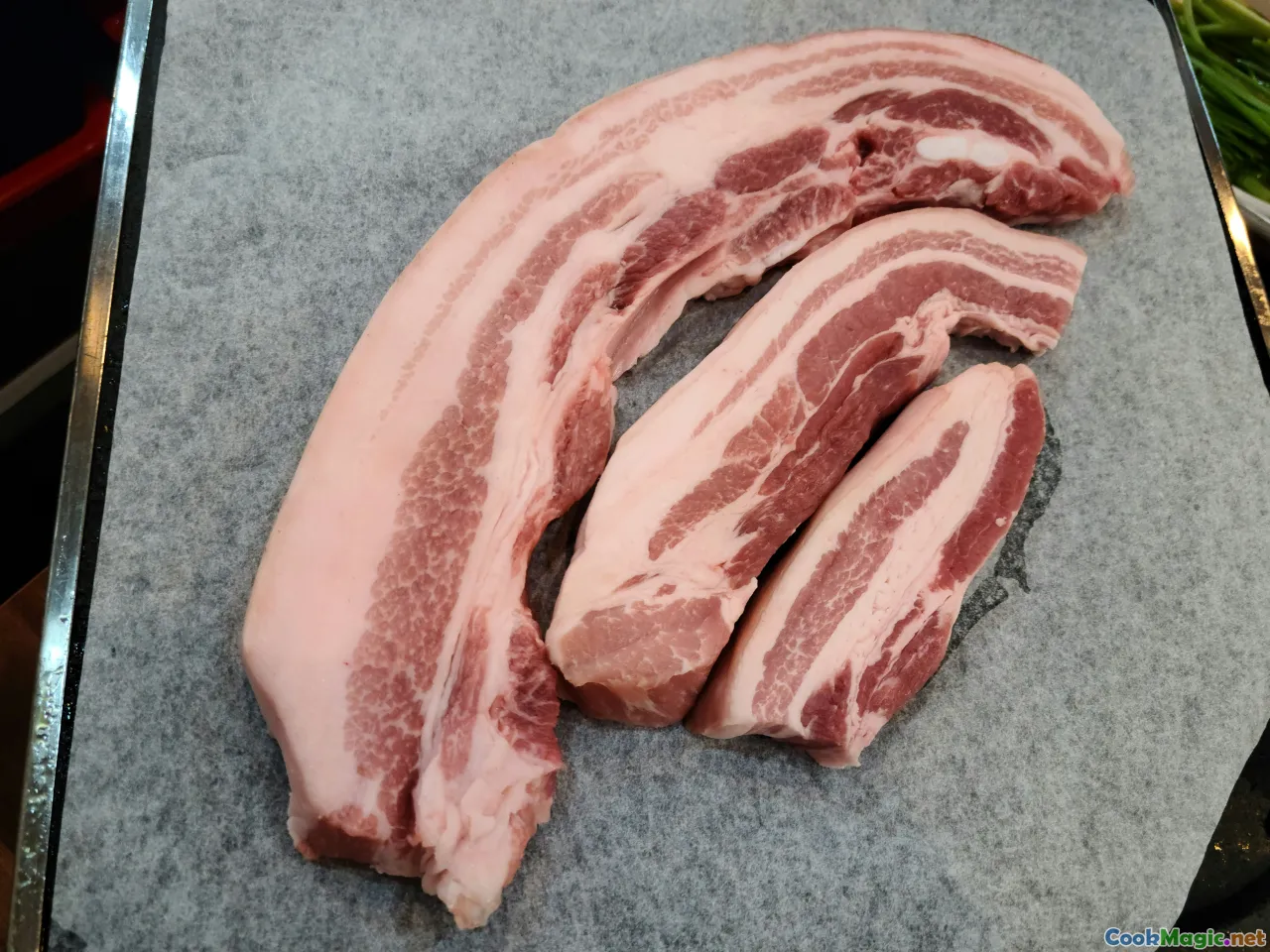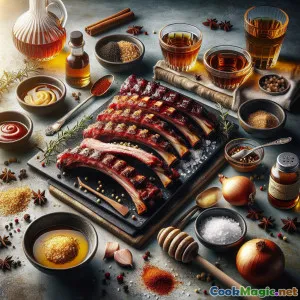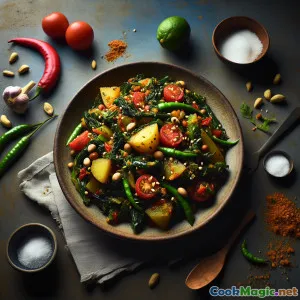
Col rizada a la sartén del sur con tocino crujiente
(Southern Skillet Collard Greens with Crispy Bacon)
(0 Reseñas)0
857
julio 16, 2025
Informar de un problema
Ingredientes
-
500 grams Col rizada
(Hojas frescas, tallos gruesos retirados y picadas)
-
150 grams Bacón
(ahumado, cortado en trocitos pequeños)
-
1 medium Cebolla amarilla
(Cortado en pequeños cubos)
-
3 cloves Ajo
(Picado)
-
2 tbsp Vinagre de sidra de manzana
(Aporta brillo a las verduras verdes.)
-
400 ml caldo de pollo
(Se puede sustituir por caldo de verduras para una opción vegetariana.)
-
1 tbsp Aceite de oliva
(Realza el sabor, especialmente para que el tocino quede crujiente.)
-
0.5 tsp Copos de pimiento rojo
(Opcional, para un toque suave de picante.)
-
0.5 tsp Sal
(Probar y ajustar según sea necesario.)
-
0.5 tsp Pimienta negra
(Pimienta recién triturada o molida)
(Hojas frescas, tallos gruesos retirados y picadas)
(ahumado, cortado en trocitos pequeños)
(Cortado en pequeños cubos)
(Picado)
(Aporta brillo a las verduras verdes.)
(Se puede sustituir por caldo de verduras para una opción vegetariana.)
(Realza el sabor, especialmente para que el tocino quede crujiente.)
(Opcional, para un toque suave de picante.)
(Probar y ajustar según sea necesario.)
(Pimienta recién triturada o molida)
Nutrición
- Porciones: 4
- Tamaño de porción: 1 tazón (200g)
- Calories: 195 kcal
- Carbohydrates: 10 g
- Protein: 11 g
- Fat: 12 g
- Fiber: 4 g
- Sugar: 2 g
- Sodium: 550 mg
- Cholesterol: 25 mg
- Calcium: 130 mg
- Iron: 1.8 mg
Instrucciones
-
1 - Prepara las hojas de col rizada.:
Elimina los tallos gruesos de las hojas de col verde. Enjuágalas bien, luego apílalas, enróllalas y corta las hojas en tiras finas.
-
2 - Haz que el tocino quede crujiente:
Añade aceite de oliva a una sartén grande a fuego medio. Cocina las tiras de tocino hasta que estén crujientes, aproximadamente 5–7 minutos. Retíralas con una espumadera y reserva, dejando la grasa en la sartén.
-
3 - Sofreír cebolla y ajo:
Añade la cebolla picada a la sartén con la grasa de tocino. Sofríe hasta que la cebolla esté blanda, unos 3 minutos; luego añade el ajo y sofríe 1 minuto más hasta que desprenda aroma.
-
4 - Cocina las hojas de berza:
Añade hojas de collard a la sartén. Remueve para cubrirlas y cocina 2-3 minutos. Vierte caldo de pollo, lleva a un ligero hervor, tapa y cocina 10-12 minutos, removiendo ocasionalmente, hasta que las hojas estén tiernas.
-
5 - Sazona y añade tocino.:
Quita la tapa. Revuelve con vinagre de sidra de manzana, copos de pimiento rojo (si los usas), sal y pimienta negra. Devuelve el tocino a la sartén y mezcla todo bien. Cocina a fuego suave, destapado, hasta que la mayor parte del líquido se evapore.
-
6 - Servir:
Prueba para sazonar, luego traslada las hojas de collard con tocino a tazones para servir. Sirve caliente como guarnición o como un almuerzo abundante.
Elimina los tallos gruesos de las hojas de col verde. Enjuágalas bien, luego apílalas, enróllalas y corta las hojas en tiras finas.
Añade aceite de oliva a una sartén grande a fuego medio. Cocina las tiras de tocino hasta que estén crujientes, aproximadamente 5–7 minutos. Retíralas con una espumadera y reserva, dejando la grasa en la sartén.
Añade la cebolla picada a la sartén con la grasa de tocino. Sofríe hasta que la cebolla esté blanda, unos 3 minutos; luego añade el ajo y sofríe 1 minuto más hasta que desprenda aroma.
Añade hojas de collard a la sartén. Remueve para cubrirlas y cocina 2-3 minutos. Vierte caldo de pollo, lleva a un ligero hervor, tapa y cocina 10-12 minutos, removiendo ocasionalmente, hasta que las hojas estén tiernas.
Quita la tapa. Revuelve con vinagre de sidra de manzana, copos de pimiento rojo (si los usas), sal y pimienta negra. Devuelve el tocino a la sartén y mezcla todo bien. Cocina a fuego suave, destapado, hasta que la mayor parte del líquido se evapore.
Prueba para sazonar, luego traslada las hojas de collard con tocino a tazones para servir. Sirve caliente como guarnición o como un almuerzo abundante.
Más información sobre: Col rizada a la sartén del sur con tocino crujiente
Collard Greens with Bacon — Southern Tradition in Every Bite
Collard greens have a deeply rooted history in Southern American cuisine, stretching back over generations and oceans. Originating in Africa and Europe, leafy greens like collards became staple crops across the southern United States due to their resilient nature and hearty, nutritious leaves. Collard greens with bacon is an iconic dish—earthy greens slow-simmered until melt-in-your-mouth tender, enriched with smoky bacon, sweet onions, and spiked with a splash of vinegar to balance the richness.
History & Cultural Significance
For enslaved African Americans residing in the Antebellum South, collards were cultivated in gardens as essential sources of nutrition. Traditionally, they were slow-cooked with smoked meats (ham hocks, fatback, or bacon) to bring extra body and warmth, flavors that became emblematic of African American and Southern cuisine. Every Black family, and indeed, many white households in places like Georgia, the Carolinas, and Alabama developed their own approaches to seasoning, braising, and serving collard greens, often with personal or regional flourishes.
The custom of adding vinegar reflects West African cooking traditions, where acid is often used to brighten the intensity of long-cooked stews. Even today, a jar of peppered vinegar frequently sits on the table alongside greens.
Personal Tips & Notes
- Prepping the Greens: Always remove the thick center ribs—these don't tenderize well and can add unwanted bitterness. For speed, try stacking several leaves, rolling tightly, and slicing into 'chiffonade' style ribbons.
- Choosing Bacon: Use high-quality, smoky bacon for depth. Alternatively, try adding chopped smoked sausage or a ham hock for even more flavor, or opt for a plant-based bacon or smoked tofu for a vegetarian version.
- Simmering Liquid: Chicken stock gives a rounded base, but if making vegetarian, try mushroom or vegetable stock with a splash of smoked paprika.
- Final Touch: The table vinegar is traditional—pass a small bottle for diners wishing to add extra tang. Vinegar can cut through the greens' natural brassica bitterness and bacon's richness at the last second.
- Leftovers & Storage: These collard greens taste even better the next day. Refrigerate in an airtight container and enjoy within three days. Reheat gently over the stove with a splash of water or stock to restore moisture.
Creative Variations
For an intriguing, creative spin, add chopped sun-dried tomatoes or a pinch of brown sugar at the end for sweetness, or toss in a can of drained white beans to make a complete one-skillet meal. Chopped jalapeños roasted with bacon briefly or a sprinkle of toasted pecans over the top brings new depths and crunch. Steep collards in miso-infused broth for a unique global twist.
Beyond the Side — Serving Ideas
While classic Southern plates offer collards alongside cornbread, barbecue meats, or fried chicken, don’t hesitate to serve these as a main element for lunch over cheesy grits, as part of a rice bowl, or folded into a breakfast sandwich with egg. Their savory and comforting taste profile brings a warm balance at any time of day.
Quick Nutrition Glimpse
Collards bring potent doses of vitamins A, C, and K, calcium, and dietary fiber, supporting strong bones and digestion. Coupled with protein and healthy fats from bacon, this dish is a filling source of comfort-food nutrition.
The joyous blend of old-world culinary knowledge refined on this continent makes collard greens with bacon more than a recipe—it’s a celebration of history, resourcefulness, and flavor. Whether you grew up alongside a pot of simmering greens or you’re trying this Southern mainstay for the very first time, you’re partaking in a beloved legacy that links countless kitchens across centuries.
























